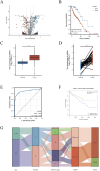Investigation of the correlation between AGRN expression and perineural invasion in colon cancer
- PMID: 39691475
- PMCID: PMC11649504
- DOI: 10.3389/fmolb.2024.1510478
Investigation of the correlation between AGRN expression and perineural invasion in colon cancer
Abstract
Background and purpose: Colon cancer is one of the most common gastrointestinal malignancies. According to the traditional view, the primary modes of transmission include direct dissemination, hematogenous metastasis, and lymph node metastasis. In recent years, the role of perineural invasion (PNI) in the spread and metastasis of tumors has received immense attention. However, there are still relatively few reports on the potential mechanisms and biomarkers of PNI occurrence and development in colon cancer.
Method: We identified genes linked to the onset and progression of PNI in colon cancer using bioinformatics tools and extensive databases. Gene function enrichment analysis was used to explore the potential roles of these genes in tumor proliferation, invasion, and PNI. A collection of postoperative pathological specimens from colon cancer patients who underwent surgery, related clinicopathological data, and immunohistochemistry were used to validate AGRN expression in PNI tissues.
Results: Bioinformatics analysis revealed that AGRN is overexpressed in colon cancer tissues and correlates with poor patient prognosis. The findings from gene association and enrichment studies indicate that AGRN and its associated genes may play a role in PNI development and progression in colon cancer by simultaneously enhancing tumor cell invasion and neural cell growth. Immunohistochemical analysis of clinical samples confirmed that AGRN expression is elevated in colon cancer tissues with PNI.
Conclusion: We found that AGRN is significantly overexpressed in colon cancer tissues exhibiting PNI and is linked to poor patient survival. AGRN and its related genes may contribute to PNI by promoting tumor cell invasion and neural cell growth. Hence, AGRN may play a crucial role in the initiation and progression of PNI in colon cancer.
Keywords: AGRN; bioinformatics; colon cancer; immunohistochemistry; perineural invasion.
Copyright © 2024 Chen, Zhang, Gao, Meng, Yang, Li, Wang and Tai.
Conflict of interest statement
The authors declare that the research was conducted in the absence of any commercial or financial relationships that could be construed as a potential conflict of interest.
Figures







Similar articles
-
Correlation of NPDC1 Expression and Perineural Invasion Status with Clinicopathological Features in Patients with Colon Cancer.Int J Gen Med. 2023 Oct 6;16:4549-4563. doi: 10.2147/IJGM.S428590. eCollection 2023. Int J Gen Med. 2023. PMID: 37822345 Free PMC article.
-
Relationship between autophagy and perineural invasion, clinicopathological features, and prognosis in pancreatic cancer.World J Gastroenterol. 2017 Oct 28;23(40):7232-7241. doi: 10.3748/wjg.v23.i40.7232. World J Gastroenterol. 2017. PMID: 29142470 Free PMC article.
-
The prognostic and predictive significance of perineural invasion in stage I to III colon cancer: a propensity score matching-based analysis.World J Surg Oncol. 2024 May 11;22(1):129. doi: 10.1186/s12957-024-03405-6. World J Surg Oncol. 2024. PMID: 38734718 Free PMC article.
-
Perineural Invasion Is a Significant Indicator of High Malignant Degree and Poor Prognosis in Esophageal Cancer: A Systematic Review and Meta-Analysis.Front Oncol. 2022 Jun 8;12:816270. doi: 10.3389/fonc.2022.816270. eCollection 2022. Front Oncol. 2022. PMID: 35756642 Free PMC article.
-
Perineural invasion in colorectal cancer: mechanisms of action and clinical relevance.Cell Oncol (Dordr). 2024 Feb;47(1):1-17. doi: 10.1007/s13402-023-00857-y. Epub 2023 Aug 23. Cell Oncol (Dordr). 2024. PMID: 37610689 Free PMC article. Review.
References
LinkOut - more resources
Full Text Sources

